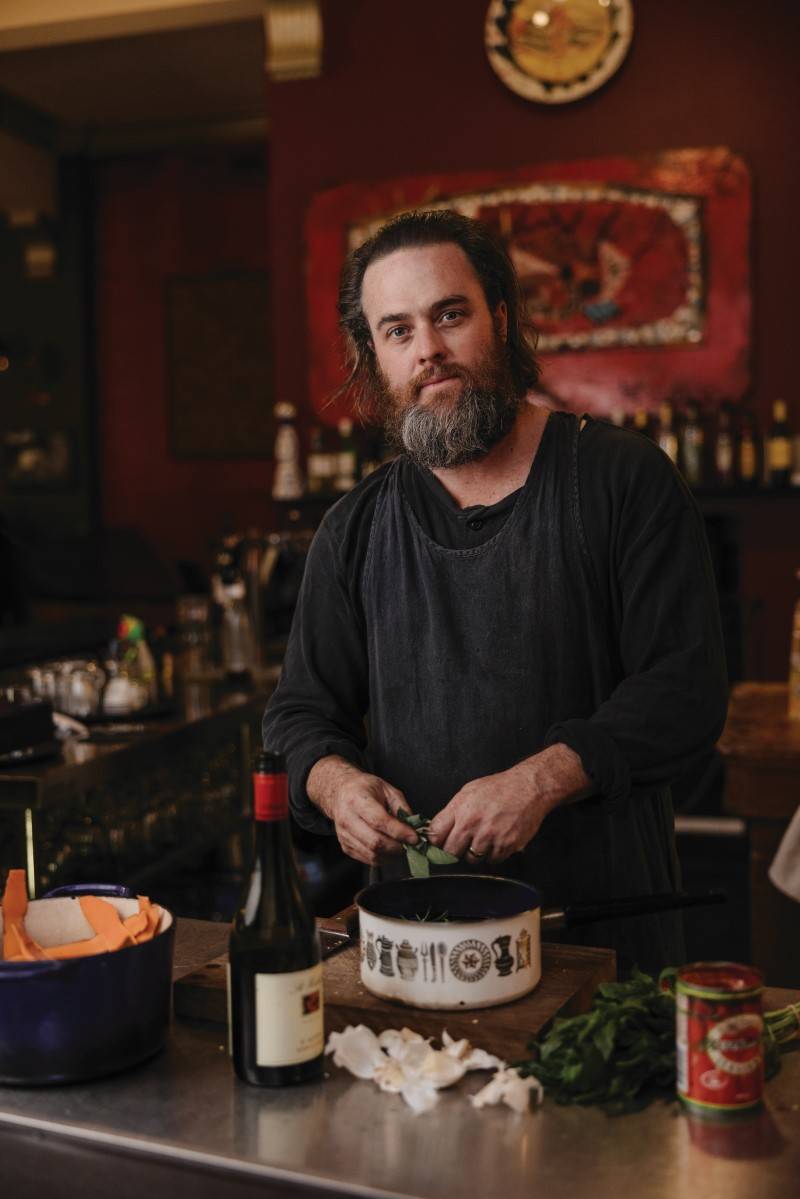James Drinkwater: The Theatre of Domesticity
James Drinkwater’s latest works were conceived during his 2021 stay in artist Julian Schnabel’s Long Island holiday house. But then, he let time do its work on his memories.
Words: Luke Létourneau
Photography: Ben Adams
James Drinkwater is a painter attuned to the minutia of his adventures. His thick and gestural works reimagine the chapters of his life. His latest series American Salt: Montauk to the Bowery has been crafted as a response to a seven-week period in New York in late 2022 and will debut at Nanda\Hobbs, Sydney in July, 2023.
I met with Drinkwater at his Newcastle home and studio as many of the works were being formed. “The show is processing that whole experience [of New York],” he tells me over lunch. “My practice is about celebrating the theatre of the domestic. So, the show is about that time in America, and what we saw.”
The impetus for the trip came via invitation from artist and filmmaker Julian Schnabel. The two met through a mutual surfing buddy on the Northern Beaches and kept in touch, sending catalogues and letters back and forth, which led to Schnabel offering Drinkwater and his family to stay at his holiday home and studio in Montauk, Long Island.
He shows me pictures of the studio, which looks as big as a community hall, has no roof and floor decking like an ocean liner. While he urgently painted many works in that studio, the paintings for American Salt have been produced in Newcastle. Drinkwater takes a lot of joy in transforming memories into artworks. “I left a gap before painting this series, which is nice because memories can distort and embellish, especially when you start to think about them in pictorial terms,” he says. In different paintings I see diners with their bowls of spaghetti, fishnet stockings and overhanging toenails, crusty Hamptons beach scenes and energetic jazz bars.
In explaining the origins of his exhibition title, he tells me about how his senses were activated on the drive from the airport to the studio: “one of [Schnabel’s] guys picked us up from the airport to take us out to his house, which is at the end of the spine of the peninsula. As we were on the coast, I wound down the window, because it was hot, and all this humid salt in the air fell into the car. It felt different. And so American Salt stayed with me from that moment.”
It seems that his New York was also one where the glamour is a little threadbare. As I look at these paintings, I get the image of the artist fiddling with loose threads in thrift stores trying to harness the memory of the feeling. This sense of the aged comes through with some of the technical applications of paint for these new works. “Oil paint wants to be shiny,” he tells me, brush in hand. “Often at the end of the day I’ll put my brushes in water, and because oil and water don’t mix the paint doesn’t dry out. But it does take away the shine, it’s a beautiful thing that accelerates the look of the age of the paint.” And then he flicks the watery brush at an almost-finished beach scene, dabbing a figure with a matte pigment. “I’m touching on all of that dusty glamour.”
A key period of his travels was also spent at The Bowery Hotel, a seemingly glamorous hotel with a speakeasy mystery. Each night as Drinkwater was winding down, he would sketch the lively characters of his nights-out on his Bowery-branded notepad. These sketches will be presented in the exhibition as an artist book and are a generous look inside the artist’s process. The pairing of these contemporaneous sketches and the paintings made months later is a wonderful insight into an artist who is putting shape and texture to memories. For an audience, every small detail is a line to picturing your own memories, a playful invitation from a similarly spirited artist.
Drinkwater is represented by Nanda\Hobbs, Sydney; Edwina Corlette Gallery, Brisbane; and Nicholas Thompson Gallery, Melbourne.
RALPH HOBBS
Director, Nanda\Hobbs Gallery, Sydney
Representing James Drinkwater for nine years, Ralph Hobbs notes there is a vibrancy to his mark making: “from ink to charcoal through to viscous oil paint – the magic of the fluidity of his line is combined with a narrative that poetically morphs between family history, place and an abstraction drawn from his personal motifs.”
“There has been extraordinary interest from New York and significant regional gallery shows,” Hobbs continues, “including the survey show at the Drill Hall Gallery at ANU from 24 June to 20 August. Although relatively new to the auction rooms – his recent auction activity is keeping pace with the primary market pricing. In addition, strong demand from collectors is ongoing in primary and secondary markets. The pricing is in line with recent shows of the artist’s work. While there is a lot of attention on him, and there has been for a few years now, we are keen for people to be able to participate in collecting his work. Both James and the gallery are keen for his career to burn bright in the eyes of collectors for decades to come.
“Generally speaking, James’ exhibitions sell out. Collectors are always asking for his work, and it is vital to be on the gallery list for his exhibitions. He pushes the boundaries every show – some collectors like different sorts of work from him; he is not an artist that paints for a market. He paints for himself – he also creates work that is not for the commercial world. His recent ballet production Storm Approaching Wangi and Other Desires is an example of following a passion that informs his painting. His vitality transcends methodology.”
TERENCE MALOON
Director, Drill Hall Gallery, Canberra
“Early recognised as an exceptional talent, James Drinkwater has never toned-down the intensity and bravura of his approach to painting. His work has mined a vast legacy of modern art – Australian, British, American, French – as if all of it remains relevant, fresh and available to him. His paintings embrace great variety and complexity. Their formal make up, tonal intricacy and textural complexity relate them directly to representational paintings, while paradoxically they are also cunningly composed abstractions.
“Drinkwater is concerned to maintain maximum inclusiveness in regard to his viewers, irrespective of their age, educational background or prior experience. His paintings seek to connect viscerally with the viewer. Drinkwater’s exuberant use of oil paint produces a very distinctive richness of substance… he weaves layers of representational elements together in a striking condensation of interest.”
This article was originally published in Art Collector issue 105, July-September 2023.











